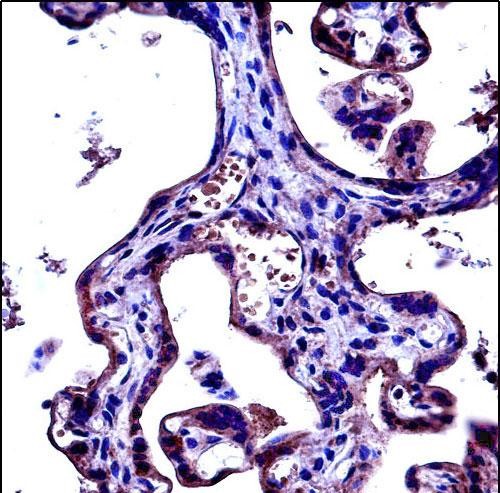CD97 Antibody (C-term)
Affinity Purified Rabbit Polyclonal Antibody (Pab)
- 产品详情
- 实验流程
- 背景知识
Application
| WB, IHC-P, E |
|---|---|
| Primary Accession | P48960 |
| Other Accession | NP_001775.2, NP_510966.1, NP_001020331.1 |
| Reactivity | Human |
| Host | Rabbit |
| Clonality | Polyclonal |
| Isotype | Rabbit IgG |
| Calculated MW | 91869 Da |
| Antigen Region | 707-736 aa |
| Gene ID | 976 |
|---|---|
| Other Names | CD97 antigen, Leukocyte antigen CD97, CD97, CD97 antigen subunit alpha, CD97 antigen subunit beta, CD97 |
| Target/Specificity | This CD97 antibody is generated from rabbits immunized with a KLH conjugated synthetic peptide between 707-736 amino acids from the C-terminal region of human CD97. |
| Dilution | WB~~1:1000 IHC-P~~1:100~500 E~~Use at an assay dependent concentration. |
| Format | Purified polyclonal antibody supplied in PBS with 0.09% (W/V) sodium azide. This antibody is purified through a protein A column, followed by peptide affinity purification. |
| Storage | Maintain refrigerated at 2-8°C for up to 2 weeks. For long term storage store at -20°C in small aliquots to prevent freeze-thaw cycles. |
| Precautions | CD97 Antibody (C-term) is for research use only and not for use in diagnostic or therapeutic procedures. |
| Name | ADGRE5 (HGNC:1711) |
|---|---|
| Function | Receptor potentially involved in both adhesion and signaling processes early after leukocyte activation. Plays an essential role in leukocyte migration. |
| Cellular Location | Cell membrane {ECO:0000250|UniProtKB:Q9Z0M6}; Multi-pass membrane protein |
| Tissue Location | Broadly expressed, found on most hematopoietic cells, including activated lymphocytes, monocytes, macrophages, dendritic cells, and granulocytes. Expressed also abundantly by smooth muscle cells. Expressed in thyroid, colorectal, gastric, esophageal and pancreatic carcinomas too. Expression are increased under inflammatory conditions in the CNS of multiple sclerosis and in synovial tissue of patients with rheumatoid arthritis. Increased expression of CD97 in the synovium is accompanied by detectable levels of soluble CD97 in the synovial fluid |
For Research Use Only. Not For Use In Diagnostic Procedures.
Provided below are standard protocols that you may find useful for product applications.
BACKGROUND
This gene is a member of the EGF-TM7 family of class II seven-span transmembrane (7-TM) molecules, likely encoded by a gene cluster on the short arm of chromosome 19. The encoded product is a glycoprotein that is present on the surface of most activated leukocytes and spans the membrane seven times, which is a defining feature of G protein-coupled receptors. The protein has an extended extracellular region with several N-terminal epidermal growth factor (EGF)-like domains, which mediate binding to its cellular ligand, decay accelerating factor (DAF, CD55), a regulatory protein of the complement cascade. The presence of structural features characteristic of extracellular matrix proteins and transmembrane proteins suggests that this protein is a receptor involved in both cell adhesion and signaling processes early after leukocyte activation. Alternative splicing has been observed for this gene and three variants have been found.
REFERENCES
Bailey, S.D., et al. Diabetes Care 33(10):2250-2253(2010)
Liu, D., et al. Int. J. Oncol. 36(6):1401-1408(2010)
Han, S.L., et al. Int J Colorectal Dis 25(6):695-702(2010)
van Eijk, M., et al. Immunol. Lett. 129(2):64-71(2010)
Davila, S., et al. Genes Immun. 11(3):232-238(2010)
终于等到您。ABCEPTA(百远生物)抗体产品。
点击下方“我要评价 ”按钮提交您的反馈信息,您的反馈和评价是我们最宝贵的财富之一,
我们将在1-3个工作日内处理您的反馈信息。
如有疑问,联系:0512-88856768 tech-china@abcepta.com.























 癌症的基本特征包括细胞增殖、血管生成、迁移、凋亡逃避机制和细胞永生等。找到癌症发生过程中这些通路的关键标记物和对应的抗体用于检测至关重要。
癌症的基本特征包括细胞增殖、血管生成、迁移、凋亡逃避机制和细胞永生等。找到癌症发生过程中这些通路的关键标记物和对应的抗体用于检测至关重要。 为您推荐一个泛素化位点预测神器——泛素化分析工具,可以为您的蛋白的泛素化位点作出预测和评分。
为您推荐一个泛素化位点预测神器——泛素化分析工具,可以为您的蛋白的泛素化位点作出预测和评分。 细胞自噬受体图形绘图工具为你的蛋白的细胞受体结合位点作出预测和评分,识别结合到自噬通路中的蛋白是非常重要的,便于让我们理解自噬在正常生理、病理过程中的作用,如发育、细胞分化、神经退化性疾病、压力条件下、感染和癌症。
细胞自噬受体图形绘图工具为你的蛋白的细胞受体结合位点作出预测和评分,识别结合到自噬通路中的蛋白是非常重要的,便于让我们理解自噬在正常生理、病理过程中的作用,如发育、细胞分化、神经退化性疾病、压力条件下、感染和癌症。







